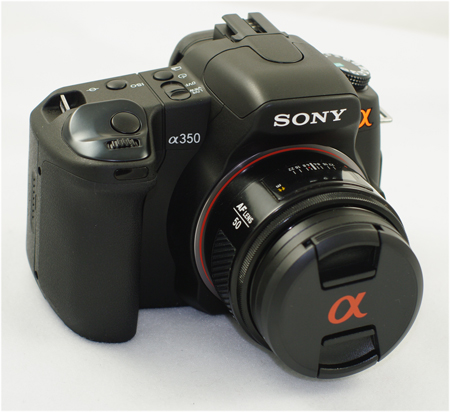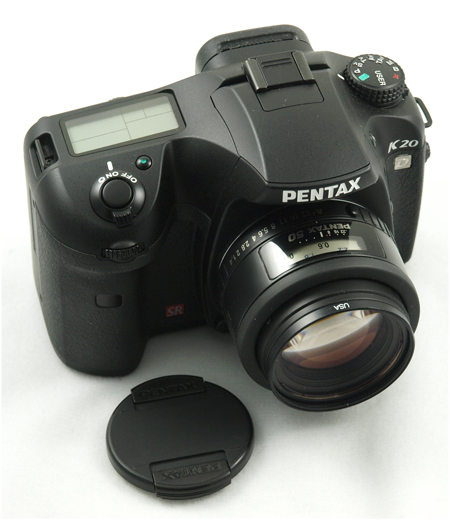Sony A350: Full-Time Live View at 14.2MP
by Wesley Fink on April 3, 2008 3:00 AM EST- Posted in
- Digital Camera
Resolution, Sensitivity and Image Quality
Sony likely wanted to scoop the industry with the 14.2MP resolution of the entry A350. That plan probably got scrapped by the 14.6MP Samsung CMOS sensor used in the prosumer Pentax K20D. While the A350 doesn't gain bragging rights as the highest res sensor south of $8000 it is still mighty close at 14.2MP. It is also the highest resolution sensor to be found in any current or announced entry-level DSLR.
Pentax went to great lengths to emphasize the greater size of their photoreceptor sites that made sensitivity more akin to the Sony/Nikon 12MP sensor. Pentax also emphasized the expanded sensitivity of their 14.6MP sensor with ISO options to 6400. Sony makes no special claims for the 14.2MP sensor in the A350, but the new sensor still has the option of ISOs to 3200.
We've already discussed how the A350 is easy to use with the best Live View you can find in a DSLR these days. The big remaining question, then, is whether the 14.2MP sensor really makes any difference in image quality.

To answer that question we considered that the most revealing test of sensitivity, noise, and resolution is low tungsten light typical of home interiors. The selected scene was not chosen to be pretty but to be revealing of sensitivity, noise, and image quality. It is a shot of my office stacked with motherboards and other review equipment taken with a standard 50mm f1.4 lens.

We found the APS-C 14.6MP CMOS sensor in the Pentax K20D to be excellent in sensitivity with well-controlled noise. The sensor size and resolution is roughly comparable to the A350, but the camera is much more expensive, uses a CMOS sensor rather than CCD, and it is targeted at the prosumer rather than entry-level. For those reasons, we included the Pentax K20D in these comparison tests.

The Canon 5D is justifiably famous for its incredible resolution with the full-frame 12.2MP CMOS sensor. The larger size sensor creates larger photo sites and the larger pixels are more sensitive to light than smaller APS-C sensors. The larger sensor size means the pixel size is more like an 8MP APS-C than a 12.2MP sensor. That makes for a good comparison to these two 14+MP sensors.
All images used a 50mm f1.4 lens (Pentax 50mm f1.4, Sony/Minolta 50mm f1.4, Canon Ultrasonic 50mm f1.4). Aperture Priority was used with a fixed aperture of f4 at all ISOs on all three cameras. Shots were taken using a tripod and remote shutter release to prevent shake. High ISO Noise Reduction used the lowest level of high ISO NR that could be selected in each camera. White Balance was manually set to Tungsten on each camera and the only light source is a 100W tungsten bulb. These harsh test conditions should make image noise as severe as you will likely see in each camera short of time-exposure darkness. Images were captured in JPEG format so they could be displayed and downloaded without the requirement for post-processing software.










113 Comments
View All Comments
Wesley Fink - Monday, March 31, 2008 - link
The Nikon D300 has an MSRP of $1799, so it is more than twice the price of the A350. As we discussed in the review the price-comparable Nikon to the A350 would be the 10 megapixel D60, which probably uses the same sensor as the Sony A200.dug777 - Monday, March 31, 2008 - link
The D60 is $749 RRP with the kit VR lens (and you can already get it for less), which is rather a gap ;)According to your table this is $899 with a kit lens...head to head with the XSi (Nikon & Canon usually bracket their cameras, both feature & price-wise, rather than going head to head).
Heidfirst - Monday, March 31, 2008 - link
D60 is 10.2Mp with no live view - Sony's competitor to that is the A200 which lists at $599 msrp with kit 18-70mm.Wesley Fink - Monday, March 31, 2008 - link
The A350 WAS compared in features and handling to other entry level DSLR cameras. The only time the K20D and Canon 5D were used for comparison was when it came to the sensor. We were trying to answer questions about the noise and sensitivity of the 14.2 megapixel CCD sensor and nothing else in entry level is higher than 10 megapixel until the Canon XSi (450D) actually ships.The Pentax K20D is similar in resolution (14.6 megapixel) but CMOS so we thought that would be an interesting comparison. The full-frame Canon 5D at 12.2 megapixel is always mentioned for it's low noise at all ISO settings so we thought that comparison might answer some questions on photosite size that inevitably come up when higher resolution sensors are the subject.
We plan to compare the Canon XSi and A350 in more detail when the XSi is available for testing. The price is almost the same which will make the comparison interesting.
haplo602 - Monday, March 31, 2008 - link
I took a look at the EXIF data of the images at ISO 100:sony:
Exposure time: 0.2
F number: 2
Focal length in 35 mm film: 75
pentax:
Exposure time: 0.166667
F number: 1.4
Focal length in 35 mm film: 75
canon:
Exposure time: 0.166667
F number: 1.4
Lens focal length: 50 (of course this is a full frame)
I wondered why is the Pentax shot so much more SOFT !!! Why the hell are you using a different F-stop on comparisons ? They have the same crop factor, so no DOF difference issue (would not be there anyway). Even the Canon was shot with F 1.4 ...
Wesley Fink - Monday, March 31, 2008 - link
This is the first attempt at the crops to compare noise at the range of ISO settings. The procedures will be refined until the procedure better converys the differences in a web view. The full images are linked as they better show what we saw in the review.Focus was manual, but we left exposure on Program assuming exposure would be the same with f1.4 prime lenses. As you point out with your EXIF data, the camera programs make different assumptions about how to handle exposure in our test lighting. In the future we will also manually control the exposure, or at least use aperture priority, to assure the same aperture at all ISOs.
The other issues were the Image Stabilization features of the Sony and Pentax. Both advise turning off IS for tripod shots which is what we did. In the future we will always use remote shutter release since the Pentax "softness" is possibly the result of not having a remote shutter elease handy for the Pentax, combined with unintended aperture variations. In fairness the Canon 5D was shot with a remote cable but it exhibits similar softness on the web screen so we plan to look more closely at the crop method as a potential problem and refine that process. The downloadable full images do a much better job of showing the noise variations.
Maxington - Monday, March 31, 2008 - link
Why were they shot at f1.4 anyhow, all lenses perform worst at wide open. (I assume thats what haplo quoted in exif data)Should be shot at f8 in raw to eliminate as much lens variation as possible between brands, and to avoid narrow DOF focus errors being classed as "soft" images.
Sony already has a slight advantage since its not shooting wide open, for example. Not that it would be noticable really.
Wesley Fink - Monday, March 31, 2008 - link
You are correct. Future comparisons will use the common f1.4 lenses where possible but aperture will be constant. We plan to use two to four stops down at f2.8 to f5.6 depending on the lighting we use for the tests. f8 is a difficult choice for low ISOs with a scene lit by a 100-watt Tungsten bulb, but it would be a reasonable choice for studio lighting.haplo602 - Monday, March 31, 2008 - link
Exactly. I was wondering why the hell is the Pentax shot so soft ...Anyway all the lenses are f1.4, so stopping down to even f5.6 for better sharpness is desired.
If you are shooting for NOISE comparisons, you always dial in the same aperture/shutter speed on each camera after first settling down on an aperture that all lenses can handle and it is not the lowest one (5.6 - 8 are ideal). this way you get a nice constant EV on all systems at the set ISO.
as to the IS being off, man I suggest you read up on the self timer feature of the bodies. I bet all of them have one. thus you don't need a remote.
anyway I'd give the Sony system the credit for choosing the best aperture in the test :-)
I also credit that you are willing to improve the testing methodology, I'd suggest you read up established lens/camera testing sites on their methodology and adapt yo your conditions.
dug777 - Monday, March 31, 2008 - link
No desire to bash you here Wes, we're just providing some constructive criticism :)I think it's great that AT is branching out into this kind of stuff, and it's pedantic people like us who let you know if we think you're not doing it right ;)
Aside, I love my ML-L3 wireless shutter release, incredibly responsive and convenient, and it's as small and simple as you'd expect it to be.